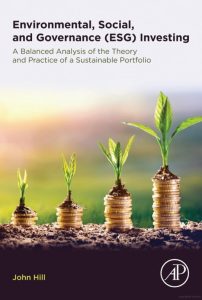When John Hill came up with the idea of writing a book about Environmental, Social, and Governance (ESG) he wanted to present a balanced and thorough analysis of ESG factors as they are incorporated into the investment process. According to the book, an estimated 25% of all new investments are in ESG funds, with a global total of $23 trillion and the U.S. accounting for almost $9 trillion.
In fact, many claim that the sustainability goals promoted by ESG, while others prefer to maximize returns and spend their earnings on social causes. According to Mr. Hill, the core problem facing those who want to promote sustainability goals is to define sustainability investing and measure its returns.
 This book examines theories and their practical implications, illuminating issues that other books leave in the shadows as it provides a dispassionate examination of ESG investing, while it also presents the historical arguments for maximizing returns and competing theories to support an ESG approach. What is more, it reviews case studies of empirical evidence about relative returns of both traditional and ESG investment approaches.
This book examines theories and their practical implications, illuminating issues that other books leave in the shadows as it provides a dispassionate examination of ESG investing, while it also presents the historical arguments for maximizing returns and competing theories to support an ESG approach. What is more, it reviews case studies of empirical evidence about relative returns of both traditional and ESG investment approaches.
The term ESG first appeared in 2005 in a landmark study entitled “Who Cares Wins” conference in 2005. That was the conference that first brought together institutional investors, asset managers, buy-side and sell-side research analysts, global consultants and government bodies and regulators to examine the role of environmental, social, and governance value drivers in asset management and financial research.
The same year, the United Nations Environment Programme Finance Initiative commissioned a report from the international law firm Freshfields Bruckhaus Deringer on the interpretation of the law with respect to investors and ESG issues. The report concluded that not only was it permissible for investment companies to integrate ESG issues into investment analysis, but it was also arguably part of their fiduciary duty to do so.




























































